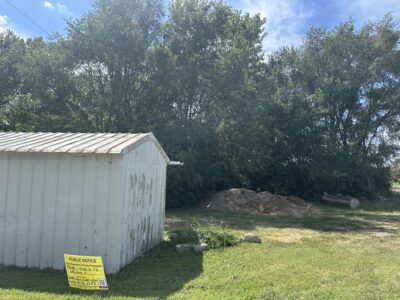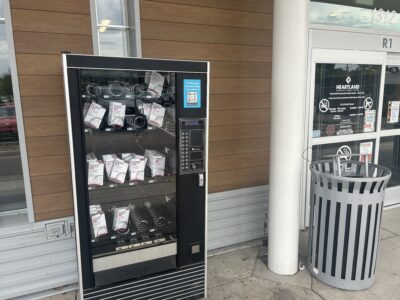Lawrence city commissioners happy to see funding for fire station in Capital Improvement Plan; they discuss adding other projects to it

photo by: Bremen Keasey
Lawrence city commissioner listening during a presentation Tuesday night about the five-year Capital Improvement Plan at City Hall.
In discussing the proposed five-year Capital Improvement Plan, Lawrence city commissioners said they were happy to see funding for a new fire station, and they expressed interest in exploring some unfunded projects further, such as affordable housing initiatives and protected bike lanes.
Commissioners got their first glance on Tuesday at the proposed five-year CIP, which acts as a blueprint for sustaining and improving community infrastructure. The CIP contains specific projects that exceed $100,000 and either create a new asset or enhance an existing asset beyond its useful life. As proposed, the five-year projected cost of the CIP would be $386 million, with roughly $157 million of projects anticipated to occur in 2026.
One of the capital projects commissioners were briefed on was a new station for Lawrence-Douglas County Fire Medical. This station, called “Station 6,” would be located in the northwest corner of the city. The plan would include about $1.5 million for the project in 2026, then about $5.4 million and $5.7 million in 2027 and 2028, respectively.
Commissioners were glad to add funding for the new station, with Commissioner Lisa Larsen saying it was an important step on a much-discussed need.
“I’m glad to finally put this in and move forward with that project,” Larsen said.
During public comments at Tuesday’s meeting, multiple firefighters applauded the city for including the project in the CIP. They said the station had been identified as a need for many years.
Alley Porter, a budget analyst with the city, said the funds for Station 6 would be included under the city’s general obligation bonds. She also said that the amounts listed in the plan wouldn’t reflect how much it would cost the city to staff the new station. She estimated it could cost about $4.7 million annually for the city to eventually fully staff it, and that the cost of a new vehicle for the station would also need to be factored in.
Commissioners also heard options for how to use the city’s Capital Sales Tax fund. Mary Bisbee, a budget analyst for the city, provided two options: one that would prioritize street maintenance funding, and one that would help complete the 22-mile Lawrence Loop trail.
Bisbee said if commissioners suggested prioritizing the Loop projects, the city would take around $2.3 million set aside for street maintenance projects and allocate it to the Loop projects. However, Bisbee noted that funding would largely cover the design process, and not the final construction costs, which would end up still being unfunded.
Several residents wrote to commissioners to urge them to prioritize the Loop, and Commissioner Bart Littlejohn said he leaned more toward that option. Other commissioners, though, said they wanted to focus on the street maintenance program. Larsen said she felt the city was “catching up” on its street work and was concerned that de-emphasizing that program would move the city backward.
The projected costs of the CIP for 2026 were lower than what was expected for 2026 in last year’s iteration of the CIP. Porter said that was because a few items — including another new fire station and a West Lawrence spray park — were marked as “unfunded” in the proposed CIP, meaning no money would be expected to be spent on them in the five-year plan.
Some other projects were considered but were not funded in the proposed CIP. These included a redesign of Tennessee and Kentucky streets that would add protected bike lanes, providing funding for affordable housing and creating a permanent pavilion for the Lawrence Farmers Market.
The commissioners expressed some interest in these ideas, however. Commissioner Amber Sellers said she was interested in the Lawrence Farmers Market project and the affordable housing funding, and that those could have a “huge community impact.” Larsen and Vice Mayor Brad Finkeldei both said the Tennessee and Kentucky street ideas were interesting, but they wanted to wait to see the impacts of a plan to add protected bike lanes along Ninth Street first.
The final CIP would be adopted alongside the 2026 budget, which the commission is scheduled to vote on on Sept. 16. The first budget proposal is scheduled to be presented to the commission on July 8.
• • •
In other business, commissioners approved a tax incentives plan for a proposed apartment development in East Lawrence.
Commissioners unanimously voted to approve development assistance for the 9 Del Lofts II project at 716 E. Ninth St, which plans for live-work units and affordable housing apartments. The incentive package includes industrial revenue bonds for a sales tax exemption on construction cost and a 95% Neighborhood Revitalization Act property tax abatement over 15 years on the valuation increase resulting from the development.
Tom Kaleko, an analyst with Baker Tilly Municipal Advisors, told commissioners the project would include six live-work units and 39 one-bedroom units, with a minimum of 24 of those one-bedroom units to be set aside as affordable housing. Kaleko also said the analysis found awarding the tax incentives would have a neutral impact while meeting other key goals from the city’s economic development policy.
Patrick Watkins, an attorney representing the applicant, Flint Hills Holdings, said the project has a “massive” amount of state and federal funds while increasing the city’s affordable housing stock. Watkins noted the incentive request is similar to some of the construction firm’s previous projects, which include the Poehler Lofts and 9 Del Lofts.
Watkins said the incentives requests for the project were specifically designed to enhance the competitiveness of its applications for federal tax credits for low-income housing, and that it was also in a final funding round for the state’s 9% affordable housing tax credits. The project has received other financial support previously, including $450,000 from the City’s Affordable Housing Trust Fund, as the Journal-World reported.
Littlejohn said since the spot is currently an empty parking lot right now, it was right to “take this opportunity” to build affordable housing there.






